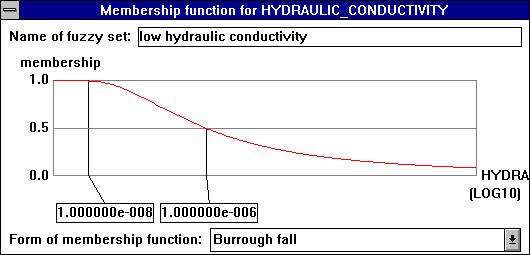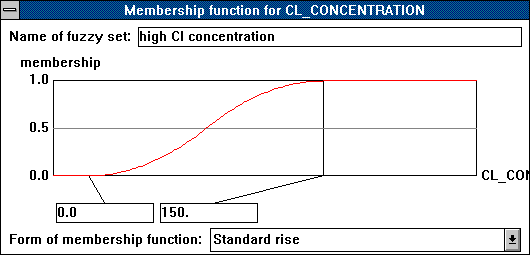FUZZEKS [to Index]
Tour: Membership functions for preparation of the aggregation
 [Example home page]
[Example home page]
 Graphical display of input parameters
Graphical display of input parameters
 Combination operators form the aggregation function
Combination operators form the aggregation function
On the next page is described how combination operators are used to form
the aggregation function. As preparation it is needed to transform the
data in order to fit the data for all parameters at the same scale.
Defining a membership function transformation for each
parameter is the method to do this.
The membership function returns a membership value in the range [0,1] for
each parameter value (0 indicates "no member at all" while 1 indicates
"member for sure").
The result of the membership function transformation must be the membership
for some
positive property with respect to the end-result (of the aggregation).
Example: The end-result is the membership of
"suitability as waste disposal site: high".
Then a positive property with respect to the end-result for
HYDRAULIC_CONDUCTIVITY is e.g. "low hydraulic conductivity".
An appropriate membership function has high values for relatively low
HYDRAULIC_CONDUCTIVITY values as can be seen in the picture below.
In order to select a membership function, the user only needs to
select the second column of the management window with the mouse.
Then the membership function window for the parameter of this row opens.
(Have a look at the next page to see the second
column.)
The example of the membership function definition for
"WATER_TABLE_DEPTH" is shown below.

In this case, the expert has defined that a value of less than 2 m means that
"large water table depth" is not true at all (membership 0) and above
5 m it is 100% true (membership value of 1).
In the range between these values the membership increases in a
normal way (like a standard rise function),
so he has chosen "Standard rise" as type of the function.
The membership function window for "HYDRAULIC_CONDUCTIVITY":

The HYDRAULIC_CONDUCTIVITY is defined to be low for sure if it is less than
1e-8 m/s. For larger HYDRAULIC_CONDUCTIVITY values the membership value then
decreases and converges to 0,
so the chosen membership function type is "Burrough fall".
The membership function takes the value 0.5 for a HYDRAULIC_CONDUCTIVITY of 1e-6 m/s.
In a similar way membership functions for "high clay content" and
"high Cl concentration" are defined:


 Combination operators form the aggregation function
Combination operators form the aggregation function
 Overview: Membership function window
Overview: Membership function window
 Membership function window:
Quick reference / Window description
Membership function window:
Quick reference / Window description

 [Example home page]
[Example home page] Graphical display of input parameters
Graphical display of input parameters Combination operators form the aggregation function
Combination operators form the aggregation function


 Overview: Membership function window
Overview: Membership function window